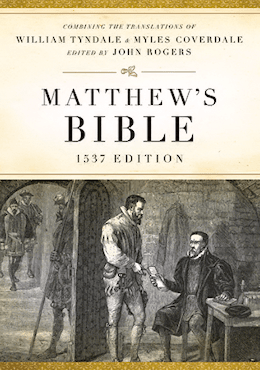Textus Receptus Bibles
Matthew's Bible 1537
| 21:1 | After that Iesus shewed hym selfe agayne at the sea of Tyberias. And on thys wise shewed he hym selfe. |
| 21:2 | Ther were together Symon Peter and Thomas, whyche is called Didimus, and Nathaniell of Cana a cytie of Galile, and the sonnes of Zebedei, and two other of the disciples. |
| 21:3 | Simon Peter sayd vnto them: I go a fyshinge. They sayd vnto hym: we also wyll go wyth the. They went theyr way and entred into a shyppe strayght waie, and that nighte caught they nothyng. |
| 21:4 | But when the mornyng was nowe come, Iesus stode on the shore: neuerthelesse the dyscyples knewe not that it was Iesus. |
| 21:5 | Iesus sayd vnto them: syre, haue ye anye meate? They aunswered him: no. |
| 21:6 | And he sayd vnto them: caste out the net on the ryght syde of the shyppe, and ye shall fynde. They caste out, and anone they were not able to draw it for the multytude of fyshes. |
| 21:7 | Then sayde the disciple whom Iesus loued vnto Peter: It is the Lord. When Simon Peter hearde that it was the Lorde, he gyrde hys mantel to him (for he was naked) and sprange into the sea: |
| 21:8 | The other discyples came by shippe for they were not farre from land, but as it were two hundred cubites, and they drewe the net wyth fyshes: |
| 21:9 | Assone as they were come to land, they sawe hote coles and fyshe, layde thereon and breade. |
| 21:10 | Iesus said vnto them: bringe of the fishe which ye haue now caught. |
| 21:11 | Simon Peter stepped forth, and drewe the net to lande full of great fyshes an hundred and .liij. And for all there were so many, yet was not the net broken. |
| 21:12 | Iesus sayde vnto them: come and dyne. And none of the discyples durst axe him, what art thou? for they knewe that it was the Lord. |
| 21:13 | Iesus then came and toke bread, and gaue them, and fyshe lykewyse. |
| 21:14 | And thys is nowe the thyrde tyme that Iesus appeared to hys discyples after that he was rysen agayne from deathe. |
| 21:15 | When they had dyned. Iesus sayd to Simon Peter: Simon Ioanna, louest thou me more then these? He sayd vnto him: ye Lorde thou knowest that I loue the. He saide vnto him: fede me lambes. |
| 21:16 | He saied to him again the seconde tyme? Simon Ioanna, louest thou me? He saied vnto him: yea Lorde thou knowest that I loue the. He saied vnto him: fede me shepe: |
| 21:17 | He saied vnto him the thyrde tyme: Simon Ioanna, louest thou me? And Peter sorowed, because he saied to him the thirde time, louest thou me, and said vnto him: Lord, thou knowest all thinge: thou knowest that I loue the. Iesus sayd vnto him: fede me shepe. |
| 21:18 | Verelie verelye, I saie vnto the, when thou waste yonge, thou girdest thy selfe, and walkedst whither thou wouldest: but when thou arte olde, thou shalt stretche forth thy handes, and another shall gyrd the, and lead the whither thou wouldest not: |
| 21:19 | That spake he, signyfyeng by what death he should glorifie God. And when he had saied thus, he sayed to hym: folowe me. |
| 21:20 | Peter tourned aboute, and sawe that disciple whom Iesus loued folowinge which also leaned on his breste at supper and saied: Lord which is he that shal betraye the? |
| 21:21 | When Peter saw him, he sayde to Iesus: Lord what shall he here do? |
| 21:22 | Iesus sayde vnto him: Yf I wyll haue him to tarye tyll I come, what is that to the? folow thou me. |
| 21:23 | Then went this saiynge abrode amonge the brethren, that that disciple shoulde not dye. Yet Iesus sayde not to hym, he shall not dye, but if I wyl that he tary tyll I come, what is that to the? |
| 21:24 | The same dyscyple is he which testifyeth of these thinges, and wrote these thinges. And we know that his testimonie is true. |
| 21:25 | Ther are also many other thinges whych Iesus dyd, the whiche if they shoulde be written euery one I suppose the worlde could not contayne the bokes that shuld be written. |

Matthew's Bible 1537
The Matthew Bible, also known as Matthew's Version, was first published in 1537 by John Rogers, under the pseudonym "Thomas Matthew". It combined the New Testament of William Tyndale, and as much of the Old Testament as he had been able to translate before being captured and put to death, with the translations of Myles Coverdale as to the balance of the Old Testament and the Apocrypha, except the Apocryphal Prayer of Manasses. It is thus a vital link in the main sequence of English Bible translations.